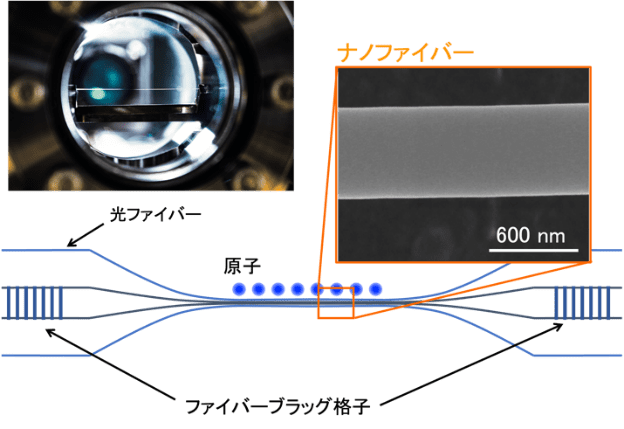Progress Report
Large-scale quantum hardware based on nanofiber cavity QED[1] Proof-of-principle of nanofiber cavity QED hardware, [4] Scaling-up and distribution, [5] Social implementation, [7] Development of next-generation cavities
Progress until FY2024
1. Outline of the project
Nanofiber cavity QED technology holds immense promise as a new form of quantum computer hardware. It employs a hybrid system, combining neutral atoms—ideal for large-scale integration—with light, which is perfectly suited for distributed systems via optical fiber networks.
Our work focuses on demonstrating the fundamental principles of this approach while simultaneously developing technologies for both large-scale integration and distributed operation. Crucially, for this new type of quantum computing system to be widely adopted, it must achieve high uptime and long-term stable operation. To that end, we're dedicated to improving the technical stability of both the nanofiber cavity QED system and its peripheral equipment, with the goal of practical application in industry and scientific research.
We anticipate offering quantum computing power through cloud-based services, making quantum computation accessible to a broad range of users. Furthermore, we are also developing next-generation resonators to significantly boost the performance of this system.

2. Outcome so far
In our proof-of-principle work, we've achieved a world-first: successfully trapping a single atom near the surface of a nanofiber cavity using optical tweezers and demonstrating its coupling with the resonator. We're actively progressing with the demonstration of fundamental elemental technologies like quantum gates. Concurrently, we're developing storage technology for ultra-low-loss nanofiber resonators, which now allows for rapid replacement of resonators in operational systems whenever needed.
For scalability, we're developing techniques to trap up to 1,000 single atoms in a one-dimensional array and couple them with nanofiber resonators. We've already successfully formed an intermediate image of a 1,000-spot optical tweezers trap and are advancing single-atom loading technology.
Regarding distributed operation, we're constructing two identical proof-of-principle machines in parallel to connect multiple units and demonstrate distributed technology.
For real-world implementation, our goal is to achieve high uptime and long-term operational stability. To this end, we've designed cloud hardware and developed prototypes to implement this NISQ (Noisy Intermediate-Scale Quantum) quantum computer through a cloud system. Essential to this is the implementation of a quantum computing unit (QPU), centered around the nanofiber resonator and using neutral atoms as qubits, along with a quantum-classical interface that connects different QPUs via an optical fiber network to enable a distributed quantum computing environment. We've modularized each QPU, devised and designed a centralized control system, integrated it into the proof-of-principle machine, and evaluated its performance, verifying its practicality. Furthermore, for long-term operation, we've completed the development and testing of a prototype remote control and auto-stabilization system for the lasers and control devices that constitute the QPU.
In the realm of next-generation resonators, we're developing a novel resonator structure that offers significantly broader bandwidth compared to conventional nanofiber resonators. In the prototyping phase, we've successfully achieved an extremely high resonator Q-factor of 107.
3. Future plans
In our ongoing proof-of-principle work, we're focused on demonstrating the fundamental elemental technologies of the nanofiber cavity QED quantum hardware. For large-scale integration, we're developing techniques to house up to 1,000 single atoms per unit. When it comes to distributed operation, our efforts are directed toward demonstrating the successful connection of multiple nanofiber cavity QED units. For social implementation, we're conducting long-duration operational tests with our proof-of-principle machine, refining the system to achieve the robustness needed to handle practical challenges. Finally, with next-generation resonators, our goal is to create resonators with significantly broader bandwidth while maintaining the same low-loss properties as conventional nanofiber resonators.
